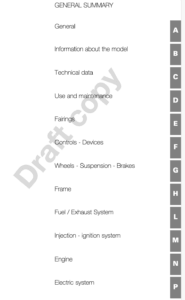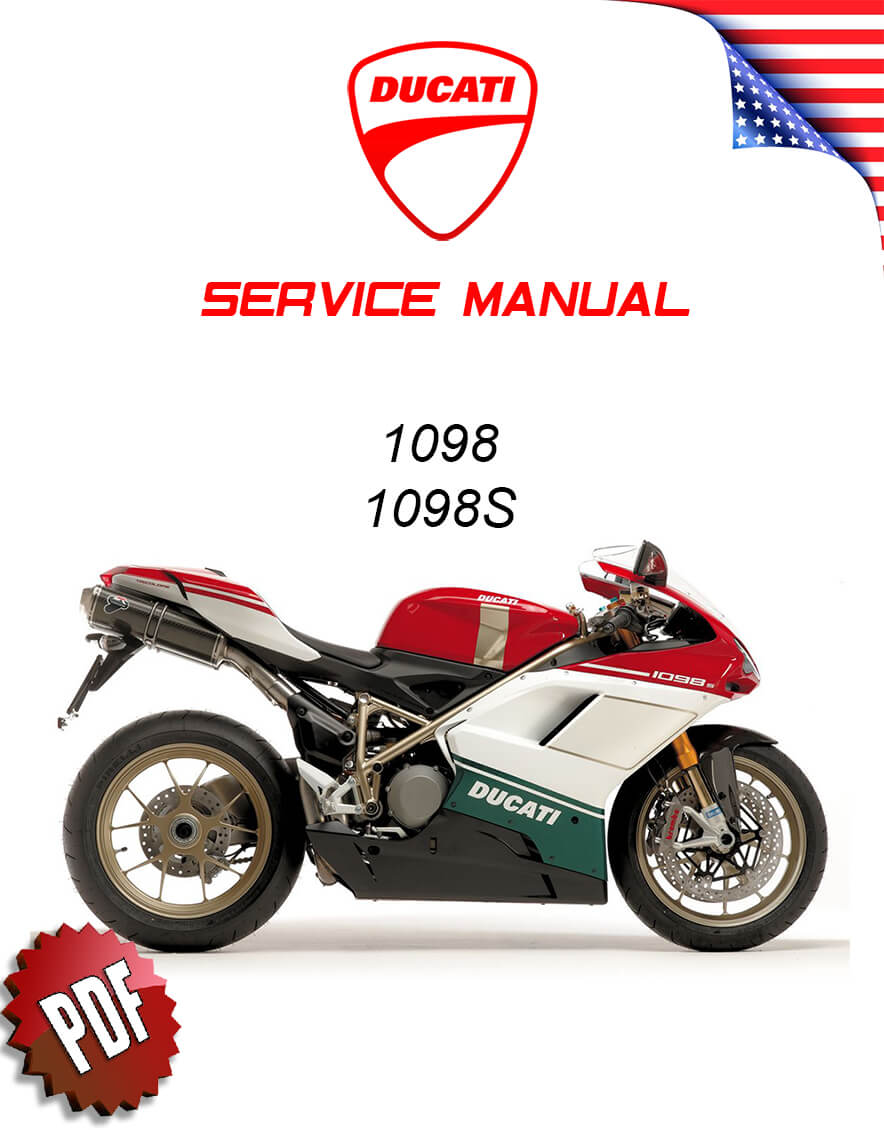Complete PDF version of the Service Manual for the Ducati 1098. A MUST for every 1098 owner.
Download: Immediately after payment!
OEM Original factory workshop manual.
Models covered by this manual: models 2007 to 2009
Number of pages: 714 pages
Table of contents:

This PDF repair manual can be downloaded right after the payment process in complete, on the device of your choice.
We do not offer printed manuals, for the following reasons:
- it is more eco-friendly to use a digital version
- your manual never gets dirty or greasy
- you can always choose to print the specific page(s) you need to work on your bike
- you receive your manual immediately after payment
- it is searchable
Ducati 1098
The Ducati 1098 is a sport bike produced by Ducati from 2007 to 2009, available in three variants: the 1098, the 1098S, and the 1098R. The 1098 was replaced by the 1198 in 2009, however the 1098R continued to be manufactured that year.
The 1098 is more similar to the older 998 than to its predecessor, the 999, with horizontally oriented headlamps and a non-integrated exhaust system. The single-sided swingarm is another holdover from the 916/998 era. Giandrea Fabbro, a Ducati designer, created the 1098.
Performance
The 1098/1098 S produces 160 horsepower (119 kW), 138 hp (103 kW) rear wheel torque, 90.4 lbft (123 Nm) torque, 77.9 lbft (106 Nm) rear wheel torque, and weights 173 kg (381 lb). The 0-60 mph pace is less than 3.0 seconds, and the 1/4 mile time is 10.015 seconds at 143.94 mph (231.65 km/h) and 173.3 mph (279 km/h). The 1098 R’s bigger displacement 1198 cc engine produces 180 horsepower (134 kW) and 99.1 lbft (134 Nm) torque, according to the manufacturer. These values give the 1098 the greatest torque-to-weight ratio of any production sport bike ever produced at the time of its debut.
Racing
Ducati said that the existing engine had reached the end of its design life (it lost up to 20 horsepower to the competition in 2007, its final year in WSBK) and that replacing it would be too expensive to make the 999 competitive. Because the 2007 WSBK regulations limited V-twin engines to 1000 cc, Ducati had no certainty that the 1098 would be qualified for entry in the premier class. Prior to the release of the 1098, Ducati petitioned the FIM to amend the WSBK regulations to accommodate its new bike, threatening to withdraw from racing if the rules were not changed. Other manufacturers were upset about racing a bike with a bigger engine, especially since it belonged to Ducati, which has traditionally dominated WSBK competition, and Suzuki even threatened to leave if the regulations were amended.
Ducati won when the FIM confirmed in June 2007 that the engine size restriction will be increased to 1200 cc for 2008. This increase in displacement, however, was not possible without Ducati making compromises. With the new 1200 cc maximum displacement for two-cylinders permitted, the further engine modifications that enabled two-cylinder motorcycles were given up. Engine modification regulations for two-cylinder and four-cylinder engines are now the same. The rules for three-cylinder engines remain unchanged.
Ducati’s 1098RS, a version of the 1098R, won the Superbike World Championship in 2008 and 2011. (Bayliss on a 1098RS and Checa on a 1198RS). The 1098RS and 1198RS were race-ready variants of the 1098R. It also won the British Superbike Championship in 2008, in addition to the two World Superbike Championships. The RS Version was never intended or legal for road usage, and it was never sold to the general public.
It had more aggressive camshafts, high compression pistons, a larger capacity fuel tank that extended under the seat, a steering damper remounted ahead of the larger fuel tank, a large capacity and pressurized radiator, a servo motor in the injection system, a longer and stiffer swingarm, a flat rocker arm for the rear suspension that allowed for full range of travel, adjustable triple clamps for variations in traction, and a servo motor in the injection system. Since the Superbike World Championship was created in 1988, Ducati has won 17 World Championships.
Remodelled for 2009
For 2009, Ducati took the 1098’s previous success and tweaked it to honor a racing great while also improving the Superbike’s performance.
Key upgrades include a 180 horsepower 90° L-twin “Testastretta Evoluzione” engine upgrade and the addition of Ducati Traction Control for improved handling. The more frequent model is the “1098-09 R,” which features the classic Ducati red fairing, black chassis, and white subframe. The rims of the wheels are gold in hue.
Ducati redesigned this bike to commemorate Troy Bayliss’ victory in the 2008 Superbike World Championship season while racing for Ducati, after which he retired. Ducati created the redesigned 1098 to honor Bayliss’s career and three World Championships. It also allowed Ducati to offer a few 1098 models with a color scheme quite close to the one used by Bayliss’ bike during his victorious races in the 2008 Grand Prix, as well as his number “21” on the side. This model is appropriately dubbed “Ducati 1098 R Bayliss Limited Edition.” Only 500 pieces of this new bike were produced, according to Ducati. Other features of the 1098 R Bayliss LE include a carbon fiber heat shield on the exhaust and 5-spoke wheels (identical to the original Bayliss). It went on to win a second world title in 2011 with Carlos Checa.
Source: Wikipedia


